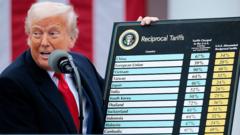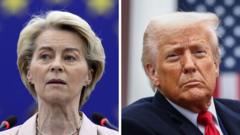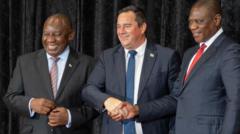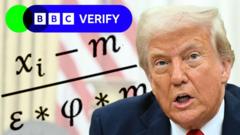Donald Trump's tariffs, implemented under a mathematical formula based on trade deficits, have sparked debate regarding their economic rationale and potential effects on global trade dynamics.
Analyzing the Mechanism Behind Trump's Tariff Calculations

Analyzing the Mechanism Behind Trump's Tariff Calculations
Examining the formula used by the Trump administration to impose tariffs on imports and its implications for international trade.
US President Donald Trump's administration has implemented a 10% tariff on imports from numerous countries, with elevated rates for what he categorizes as "worst offenders." In an effort to clarify how these tariffs were devised, BBC Verify dives into the calculations driving these economic policies.
The initial presentation of tariff figures, famously divulged during a press conference in the White House Rose Garden, led many to believe that the rates stemmed from a combination of prevalent tariffs and non-tariff barriers. However, the White House later unveiled a complicated-looking formula that, upon scrutiny, simplifies to basic arithmetic tasks. Taking the trade deficit of the United States with a given country, dividing that by total goods imports from that country, and further dividing by two provides the tariff rate.
The notion of a trade deficit arises when a nation imports more than it exports. For instance, the U.S. has a goods deficit of $295 billion with China, against total goods imports from China of $440 billion. By applying the provided formula, one arrives at a tariff of 34% for China, while the rate for the EU calculates to 20%.
Critics have identified a lack of reciprocity in Trump's tariff approach, which could traditionally mean basing new tariffs on the existing rates charged by other countries, along with their respective non-tariff barriers. The White House’s published methodology, however, indicates that this principle was not followed rigorously. Instead, tariffs were determined primarily through a strategy aimed at nullifying the U.S. goods trade deficit with each individual country, indiscriminately applying tariffs even to countries like the UK, with which the U.S. does not maintain a trade deficit.
The economic logic behind the tariffs stems from Trump's conviction that the U.S. has been at a disadvantage in global trade, exacerbated by cheaper imports that he believes undermine American manufacturing and employment. With this new tariff regime, there is an expectation that it will bolster U.S. manufacturing and protect job opportunities.
Economists consulted by BBC Verify have voiced skepticism regarding the effectiveness of this tariff system. While it might successfully diminish bilateral trade deficits with specific countries, it is unlikely to tackle the overarching U.S. trade deficit, which is shaped by deeper economic structures such as American consumer spending habits, outpacing income. Additionally, some trade deficits are based on legitimate trade patterns, like the importation of agricultural products that can be more efficiently produced in certain climates.
Thomas Sampson from the London School of Economics suggests that the formula seems to be politically motivated rather than economically justified, warning of potential negative repercussions for the global economy. The discussion around Trump's tariffs continues, raising concerns about broader international trade relations and economic stability.





















